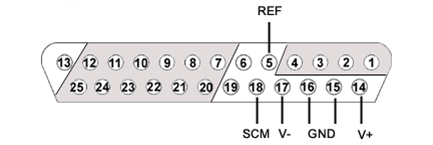RA16PA/RA4PA Medusa PreAmps
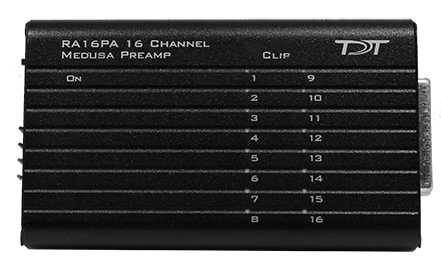
Medusa Overview
The Medusa Preamplifiers are low noise digital bioamplifiers and are available with either PCM or Sigma-Delta ADCs. The system amplifies and digitizes up to 16-channels of analog signal at a 24.414 kHz sampling rate. The amplified digital signal is sent to the base station via a noiseless fiber optic connector.
-
Digitizes either four or 16 channels at acquisition rates of approximately 6, 12, or 25 kHz.
-
Connects to the headstage via a DB25 connector.
-
Powered by a Lithium-ion battery that provides 20 hours of continuous data acquisition in 16-channel mode and 30 hours of operation in 4-channel mode.
-
Clip warning lights indicate when any signal is -3 dB from the preamplifier's maximum voltage input.
Medusa Features
Analog Acquisition Channels
The RA16PA and RA4PA standard Medusa Preamplifiers acquire signals using 16-bit PCM ADCs, which provide quality acquisition with minimal delay. The RA16SD and RA4SD use Sigma-Delta ADCs, which have several characteristics that improve signal quality. Oversampling of the signal before conversion removes aliasing of high frequency RF signals.
RA16SD testing indicates that signals greater than 150% of the Nyquist frequency are removed from the signal. This allows users to acquire at lower sampling rates (6 kHz) without worry of significant aliasing. In addition, each converter also has a two pole anti-aliasing filter (12 dB per Octave) at 7.5 kHz. However, the sigma-delta ADC's have a fixed group delay of 20 samples (compared to four samples for the RA16PA). When using the RA16SD this group delay must be taken into account when the data is displayed or acquired (for example, adding a SampDelay to the RPvdsEx circuit).
Clip Warning Lights
When the input to a channel is greater than -3 db from the preamplifier's maximum voltage input, a light on the top of the amplifier is illuminated. The first column of lights corresponds to channels 1-8 and the second column corresponds to channels 9-16. The clip warning light indicator can be turned off by flipping a switch on the end of the amplifier.
Power Light
The power light is in the top corner of the amplifier. It is illuminated when the device is on. It flashes quickly if the battery is low. It flashes slowly while the battery is charging. Note: The flashing LED indicator is only available when the amplifier is powered on and connected to a powered base station.
Headstage Connector
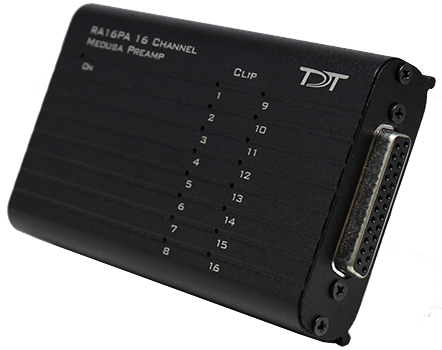
The headstage connector is a 25-pin (16-channel) connector. Information on the pin inputs is provided with the technical specifications.
Base Station Connector - To Base
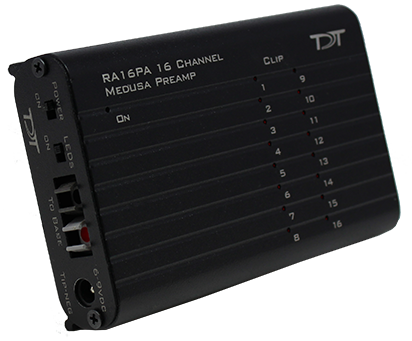
Use the provided fiber optic pair (white connectors) to connect the To Base port on the preamplifier to the optical input port on the base station.
The duplex fiber optic cable has identical one-piece connectors at each end. There is a V-shaped groove on one side of the connector and a raised rectangle on the other. As shown in the image above, plug the connector into the RZ6 port with the raised rectangle side up. Plug the connector into the preamplifier with the V-shaped groove up.
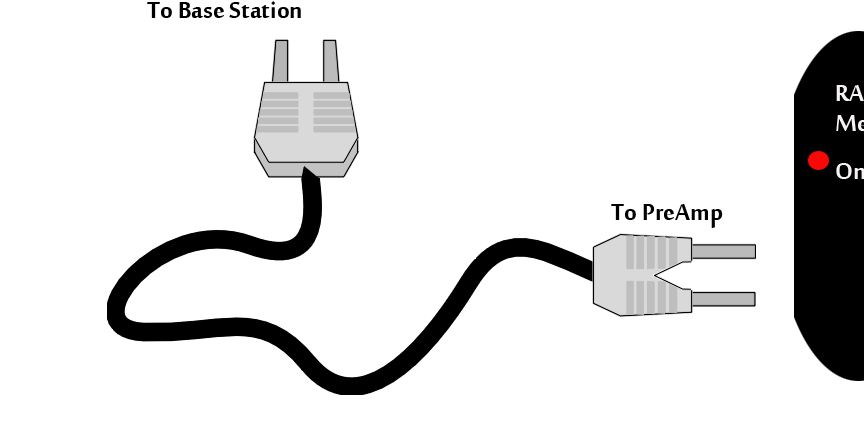 |
| Medusa PreAmp Connection Diagram |
Power
A switch on the back powers up the amplifier. The fiber connector at the right will be illuminated when the amplifier is on.
LEDs
This switch turns the clip warning lights on top of the amplifier on or off.
Power Requirements
The Lithium-ion batteries charge in four hours. Keeping the battery charger connected to the amplifier does not affect the battery life. However, the charger will significantly increase the noise of the system if it is plugged in while an experiment is running. A 6 volt battery charger is included with the amplifier. The charger tip is center negative. If it is necessary to replace the charger make sure that the power supply has the correct polarity.
The Li-ion battery supplied with the system cannot be removed. If battery life longer than 30 hours is required, an external battery pack can be connected to the voltage inputs of the charger. TDT recommends a 6 Volt (minimum) to 9 Volt (maximum) battery, such as lead acid batteries used for motorized wheel chairs. See Tech Note #0256 for more information.
RA16PA/RA4PA Technical Specifications
Includes specifications for the RA4PA, RA16PA, and RA16SD Medusa Preamplifiers.
Sample Delay
RA4PA and RA16PA sample delay depends on RZ processor sample rates. All units in samples.
Pinout Diagrams
16- and 4-channel pinouts (all models built after 2002):
